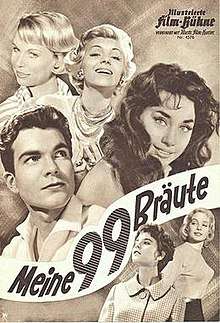My Ninety Nine Brides
My Ninety Nine Brides (German: Meine 99 Bräute) is a 1958 West German romantic comedy film directed by Alfred Vohrer and starring Claus Wilcke, Horst Frank and Wera Frydtberg.[1]
| My Ninety Nine Brides | |
|---|---|
 | |
| Directed by | Alfred Vohrer |
| Produced by | Wenzel Lüdecke |
| Written by | Sigi Sommer (novel) Franz Geiger |
| Starring | Claus Wilcke Horst Frank Wera Frydtberg |
| Music by | Martin Böttcher |
| Cinematography | Kurt Hasse |
| Edited by | Ira Oberberg |
Production company | Inter West Film |
| Distributed by | Europa-Filmverleih |
Release date | 4 December 1958 |
Running time | 86 minutes |
| Country | West Germany |
| Language | German |
It was shot at the Tempelhof Studios in Berlin. The film's sets were designed by the art director Karl Weber.
Synopsis
In Munich a womaniser who has had dalliances with ninety nine different girls eventually meets the hundredth and falls genuinely in love with her.
Cast
- Claus Wilcke as Nicki Montag
- Horst Frank as Jonny der Husar
- Wera Frydtberg as Greta Föhn
- Vera Tschechowa as Else Heer
- Corny Collins as Irmelin
- Erica Beer as Regina Hale
- Edith Hancke as Ruth
- Erna Sellmer as Frau Bittgesang
- Ingrid van Bergen as Sophie
- Bum Krüger as Herr Reif
- Inge Wolffberg as Ingrid
- Erich Fiedler as Butler
- Tilo von Berlepsch as Konsul Hale
- Wolfgang Gruner as Ansager
- Clemens Hasse as Vater Heer
- Peter Nijinskij as Pianist
- Lutz Mackensy as Eugen
- Liesl Karlstadt as Mutter Montag
- Beppo Brem as Vater Montag
- Hilde Volk as Imogen
- Edith Elmay as Lina
- Hans-Wolf Schneider as Guido
- Hans-Peter Strohkorb as Manometer-Paul
gollark: What are you using for GPTous purposes?
gollark: Hmm, do these peaks on my CPU usage graph correspond to epicbot markov utilization?
gollark: The performance is *wildly* worse on my server for no apparent reason.
gollark: I "improved" it and now it's fast on my local machine but slow on the server, hm. I bet it's an IO issue somehow.
gollark: Apparently Epicbot is somewhere where people are actually active because wow there are a lot of concurrent "loading" messages.
References
- Bock & Bergfelder p.504
Bibliography
- Bock, Hans-Michael & Bergfelder, Tim. The Concise CineGraph. Encyclopedia of German Cinema. Berghahn Books, 2009.
This article is issued from Wikipedia. The text is licensed under Creative Commons - Attribution - Sharealike. Additional terms may apply for the media files.